 What good is a trip to Italy without taking in the sights? Rome (oh so many people), Venice (get there before it’s underwater), and even a stop in Milan for some fashion tips that you know you need (yes you, in the turtleneck). But if I ever make my way to Italy, my first stop will be Florence, which may not be the most efficient travel schedule, but it works well for this intro.
What good is a trip to Italy without taking in the sights? Rome (oh so many people), Venice (get there before it’s underwater), and even a stop in Milan for some fashion tips that you know you need (yes you, in the turtleneck). But if I ever make my way to Italy, my first stop will be Florence, which may not be the most efficient travel schedule, but it works well for this intro.
Imagine with me The Florence of old. Renaissance, aristocrats, artists, and scholars. A hub of invention and design, creators of great works, many still available for the modern age to learn or gaze upon. The Princes of Florence, published by WizKids, is an updated reprint of the original 2000 release that attempts to place you and up to four friends into the mindset of a great dynasty supporting these creative endeavors. Designed by Wolfgang Kramer, Richard Ulrich, and Jens Christopher Ulrich, does a design from over two decades ago hold up as well as the greatest works of the Renaissance?
Gameplay Overview:
Over seven rounds in The Princes of Florence, players take part in two distinct phases: first the auction phase, which features bidding on estate improvements, and then the action phase, which allows players to take two actions on their turn.
Everything is in service of prestige points, which are gained by creating great works as indicated on the three starting cards each player selects. Great works require a certain value threshold to be completed, and this threshold increases each round. As an example, in the first round, this value is seven. By the seventh round the value will have increased to seventeen. The auction and action phases allow players to work toward improving the value of these great works by adding to their estate.
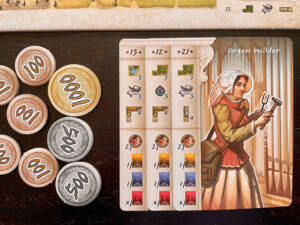
The auction is unique in that each player wins exactly one bid. Once a player has won a bid, their auction phase is complete. The first player chooses an item to auction. The starting bid is $200. Players can bid by increasing the value by $100 or they can pass and wait for a future item. Items being bid on are one of three landscapes, prestige, and recruiting cards, as well as builder and jester tokens. No item can be bid on twice.
After all players have won one auction, the action phase begins with the first player. Each player takes two actions, spending the required money to complete one of the following:
- Build a building – acquire an available building.
- Acquire a bonus card – draw five cards and choose one to add to your hand.
- Introduce a freedom – acquire an available freedom tile.
- Buy a profession card (once per round) – draw five cards and choose one to add to hand.
- Complete a great work (once per round) – calculate the value and place a pawn on the scoring track
Upon acquiring a building or landscape, players must determine how it fits on their principality board. These boards feature a preprinted palazzo, do not allow buildings to be placed adjacent, and cannot be moved once placed. If a building or landscape does not fit the grid it cannot be gained. Builder tokens can reduce the cost of buildings, as well as lift certain building restrictions, so gaining these tokens can make this puzzle less of a challenge.
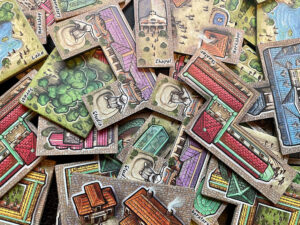
Many of the items you can gain provide value to your estate based on the profession cards in your possession. Profession cards function as contracts. Each card features a combination of landscape, freedom, and building preferences that increase their value. The value is also increased by jester tokens, as well as by profession and recruit cards in hand.
As an example, a player attempting to complete a profession in the first round needs at least seven value in their estate. The profession card values a specific landscape, building, and freedom. If the player has all three of these, they are already at ten value, which can be increased further by cards in hand as well as any jesters on their board. Each jester adds two value.
The player with the most-valued great work gains extra points, so each round brings a battle for the top spot. Players also determine how much money they want for the great work, which cuts into the number of points they receive. Both money and scoring are tight in this game, so the decision can be brutal. By the end of the seventh round, the only additional points are added by way of prestige cards gained during the auction.
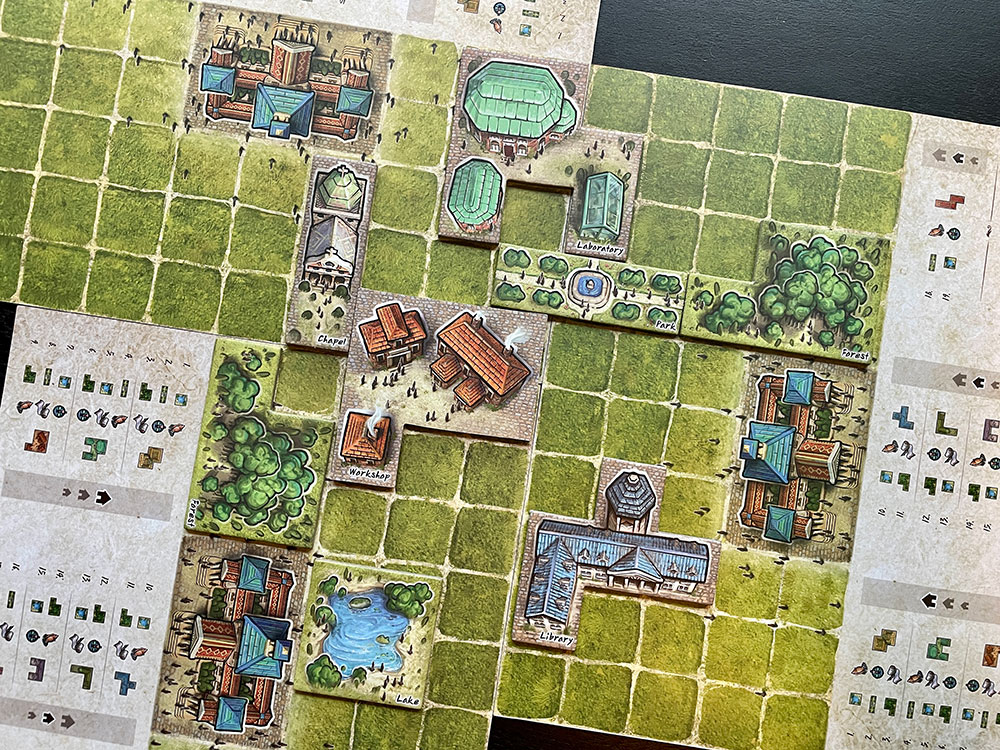
Game Experience:
All these professions are so greedy, requiring us to add a lake to the estate, as well as a certain building of their choosing, to create the greatest works. That’s about all there is to the theme of this game—make the creators happy so they can provide money and points. Thankfully, the increasing value threshold over time, as well as the continued restriction of the principality board, provide enough weight to the decision space to give the game some heft.
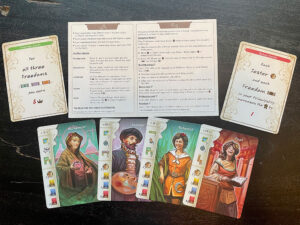
The Princes of Florence is listed as a one- to five-player game. The solo and two-player rules are not interesting, and at three players it doesn’t have enough excitement around the auction or the fight for best valued works to be worth it. I would argue that this is best at four and five players only. But at those player counts, the auction and struggle to eke out prestige each round is quite engaging. I can see why this design has been highly regarded by many euro-game fans over the years.
Everything is truly determined during the auction phase. If you lose out on a builder early, and then a jester, you must shift strategy and balance purchases with great work evaluations to press upon the competition. Being the first player is a double-edged sword; you can determine the first item up for bid, but you may find yourself in a bidding war. Going last allows a player to take the item of their choice for the minimum bid, which is excellent when things fall your way.
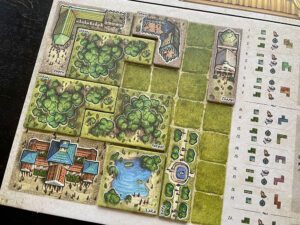
The action phase is less exciting, especially if you’re not completing a work. You get to purchase some items to improve value, you get to puzzle a building onto your estate, and you get to dig through cards and hope for the best. The rules allow players to draw five cards and choose one, which can be great for minimizing luck, but adds to downtime as players consider their options. Thankfully there’s not a lot of information to parse on cards and after a few games it’s easy to know what you need.
Kudos to Wizkids for attempting to reprint this classic. That said, it’s apparent that they did not put a lot of effort into making this a flagship revamp of the original, but rather focused on getting the old classic back into print at a decent value, but without a lot of effort put into revisions. Ont he plus side: they’ve even included the hard-to-find Muse and Princess expansion, as well as cooperative and two-player variants. So, if you’ve been meaning to seek this out and want everything, they’ve compiled it all right here for you.
Unfortunately, the lack of attention is apparent. The rulebook lacks clarity, the new artwork tries to sweep the dust off the old art style and diversify the characters (why did this still need Princes in the title?). But save for the building tiles, the art is forgettable. The card design is minimal, feeling like an afterthought, and some of the iconography isn’t as clear as it could be. There are a lot of misses here on the production side.
Final Thoughts:
The design does win out in the end. The game is fun with the right player count. It’s a bummer that it didn’t receive a new direction for its theme. Even with the focus on more diverse characters, it’s still not the most engaging space. Certainly, there’s nostalgia at play here, but finding a way to present this design to a fresh audience with a more engrossing thematic presence would’ve helped this create more intrigue. But maybe there is something behind that need to travel far to see things that’ve been crafted and marveled at for generations. Here, I think I’d prefer to marvel at the original release, even with the cracking veneer and the outdated design.
Final Score: 3 stars – A fresh coat of paint that doesn’t improve upon the original release but maintains the quality of its original design.
 Hits:
Hits:
• Money vs points
• Principality puzzle
• Unique auction phase
Misses:
• Illustration and graphic design
• An attempt to revitalize the theme
• Solo and two player modes





















